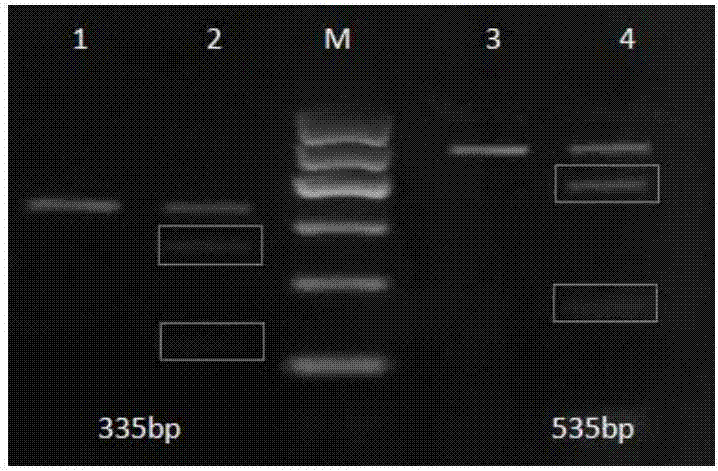CRISPR (Clustered Regularly Interspaced Short Palindromic Repeats)-Cas9 system capable of simultaneously knocking out KRAS genes and EGFR (Epidermal Growth Factor Receptor) genes and application thereof
A gene, the same technology, applied in the field of CRISPR-Cas9 system, to achieve the effect of simple operation, high knockout efficiency, and many choices
- Summary
- Abstract
- Description
- Claims
- Application Information
AI Technical Summary
Problems solved by technology
Method used
Image
Examples
Embodiment 1
[0034] 1. sgRNA design
[0035] According to the human KRAS gene sequence (Sequence ID: NM_033360.3) and EGFR gene sequence (Sequence ID: NM_201282.1) given in GeneBank, 10 sgRNAs (corresponding DNA sequences are shown in SEQ ID NO. 1-10) And SEQ ID NO. 11-20). The sgRNAs of both genes are targeted on their exon regions, and blast is used for alignment in UCSC or NCBI to ensure the uniqueness of their target sequences. Among the 10 sgRNAs designed separately, only 2 can effectively knock out KRAS and EGFR, and the first kras-sg1 (corresponding DNA sequence is shown in SEQ ID NO.1) and egfr-sg1 (corresponding DNA sequence) (As shown in SEQ ID NO.11) for detailed explanation, such as figure 1 with figure 2 Shown.
[0036] 2. Construction of sgRNA oligonucleotide duplex
[0037] Add CACC to the 5'end of the upstream primer of the determined KRAS target sequence, and add AAAC to the 5'end of the downstream primer, so that the double-stranded DNA sticky end formed after annealing and ...
Embodiment 2
[0063] T7EN1 restriction experiment:
[0064] The cells collected in Example 1 were lysed, genomic DNA was extracted with the kit, and finally dissolved in 50 μL of deionized water.
[0065] According to the KRAS gene sequence and EGFR gene sequence published by GenBank, specific primers were designed with Primer 5.0 software, as shown in Table 2:
[0066] Table 2
[0067]
[0068] Use the kit to extract part of the cell genomic DNA, use the extracted cell genomic DNA as a template, and use the specific primers designed in Table 2 to amplify the target fragment. Amplification system: 2×PCR Mix 10μL, genomic DNA 1μL, upstream and downstream primers 1μL each, add dd H 2 O to 20μL. Reaction procedure: pre-denaturation at 94°C for 5 minutes; denaturation at 94°C for 30 seconds, annealing at 60°C for 30 seconds, extension at 72°C for 35 seconds, total 30 cycles; extension at 72°C for 10 minutes; storage at 4°C.
[0069] After denaturing and renaturing 100 ng of the purified PCR product in ...
Embodiment 3
[0071] Western blot experiment:
[0072] Take 1x10 of the lung cancer cells KRAS and EGFR before and after knockout 6 After collecting the cells, add 20μL of lysis buffer (50mM HEPES, PH7.0, 1% NP-40, 5mM EDTA, 450mM Nacl, 10mM Na pyrophosphate and 50mM NaF), and add various fresh inhibitors (1mM Na orthovanadate, 1mM) to the lysis buffer. PMSF, 10μg / ml Aprotinin, Leupeptin, pepstatin). After sonication at room temperature, 1% mercaptoethanol was added, and the mixture was boiled and denatured at 100°C for 5 min. In SDS-PAGE gel, 10 μL was loaded per well. After electrophoresis, the protein sample is transferred to the nitrocellulose membrane by membrane transfer. After the transfer, the membrane was washed once with TBST, blocked with 5% skimmed milk powder for 1 hour, and washed with TBST once, and the diluted primary antibody was hybridized with the membrane at room temperature for 2 hours or overnight at 4°C. After washing three times with TTBS, hybridize the diluted second...
PUM
 Login to View More
Login to View More Abstract
Description
Claims
Application Information
 Login to View More
Login to View More - R&D
- Intellectual Property
- Life Sciences
- Materials
- Tech Scout
- Unparalleled Data Quality
- Higher Quality Content
- 60% Fewer Hallucinations
Browse by: Latest US Patents, China's latest patents, Technical Efficacy Thesaurus, Application Domain, Technology Topic, Popular Technical Reports.
© 2025 PatSnap. All rights reserved.Legal|Privacy policy|Modern Slavery Act Transparency Statement|Sitemap|About US| Contact US: help@patsnap.com



